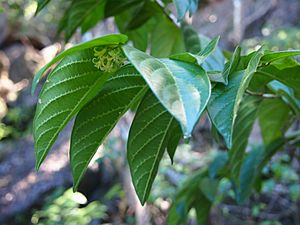Alangium villosum subsp. polyosmoides facts for kids
Quick facts for kids Black muskheart |
|
|---|---|
 |
|
| Flowers and foliage of the black muskheart, showing many small pale domatia on the underside of the leaves. | |
| Scientific classification |
|
| Kingdom: | Plantae |
| Clade: | Tracheophytes |
| Clade: | Angiosperms |
| Clade: | Eudicots |
| Clade: | Asterids |
| Order: | Cornales |
| Family: | Cornaceae |
| Genus: | Alangium |
| Species: |
A. villosum
|
| Subspecies: |
A. v. subsp. polyosmoides
|
| Trinomial name | |
| Alangium villosum subsp. polyosmoides (F.Muell.) Bloemb.
|
|
| Synonyms | |
|
|
The Black Muskheart (scientific name: Alangium villosum subsp. polyosmoides) is a cool tree found in the rainforests of eastern Australia. You can spot it growing in different types of soil and rainforests, usually not too far from the coast. It grows from Minmi near Newcastle all the way up to the McIlwraith Range in far north-eastern Australia. It's often seen as a common plant growing under taller trees at places like Wingham Brush Nature Reserve.
This tree has a few common names, like muskwood, black muskheart, brown muskheart, and canary muskheart. The first part of its scientific name, Alangium, comes from the Malabar people. It was their name for a similar tree in Asia. The second part, villosum, means "hairy" in Latin. The subspecies name, polyosmoides, means its leaves look a bit like those of another plant group called Polyosma.
Contents
What Does It Look Like?
The Black Muskheart is usually a small to medium-sized tree. It can grow up to 20 metres (about 70 feet) tall. Its trunk can be as wide as 90 centimetres (about 3 feet) across. Bigger trees might have a wide, flared base called a buttress.
Its Bark and Branches
The bark of the tree is mostly greyish-brown. It has small bumps, scales, and corky bits. These are called lenticels. The smaller branches are thin and grey. However, the tips of the branches, near the new leaves, are often hairy and green. For this specific type of Black Muskheart, the tiny twigs between the leaves are not very hairy.
Its Leaves
Mature leaves are usually between 4 and 15 centimetres (about 1.5 to 6 inches) long. They are about 2 to 4 centimetres (about 0.8 to 1.6 inches) wide. Younger leaves can be even bigger. They grow alternately along the stem, meaning they don't grow directly opposite each other. Each leaf has a fairly long, pointed tip.
The leaves are shaped like an oblong (a stretched oval) or an ellipse. The base of the leaf is often a bit uneven. You can easily see the main vein (midrib) and the side veins on the underside of the leaf. There are also many small, yellow bumps along these veins. These bumps make it easy to identify this tree in the rainforest! The stem that holds the leaf is about 6 to 13 millimetres long.
Flowers and Fruit
The Black Muskheart produces pale yellow flowers. They grow in small clusters called cymes from the axils (the spot where a leaf meets the stem). Each cluster has about three to five flowers. These flowers have a lovely honeysuckle smell.
When Do Flowers and Fruit Appear?
The flower clusters are usually less than 2 centimetres long. You can see them from October to April. Each flower has 4 to 6 petals. The petals are about 2 millimetres wide and 5 millimetres long.
The fruit of the Black Muskheart is a dark, oval-shaped drupe. It's black or almost black when ripe. The fruit is ribbed and about 10 to 20 millimetres long. It ripens from September to February. Many rainforest birds love to eat these fruits. This includes the rose-crowned fruit-dove, the topknot pigeon, and the wompoo fruit-dove. Inside each fruit is a single, pointed seed, about 10 millimetres long.

